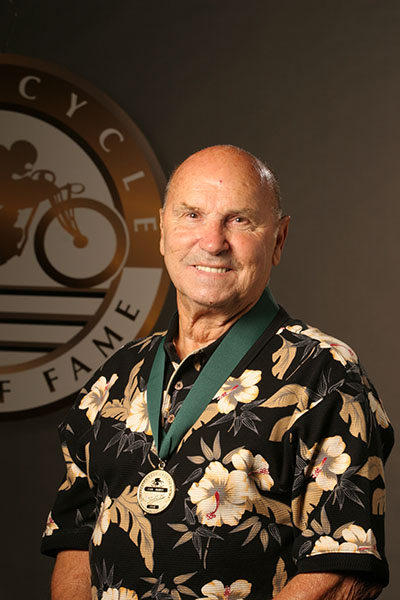 Jerry
Branch earned a reputation as one of the best engineers of racing
motors in the second half of the 20th century. He specialized in engine
airflow and worked extensively with Harley-Davidson, helping develop
the heads for the famous XR racer. He also did important development
work for several manufacturers in AMA Superbike racing during the 1970s
and 1980s. Branch also assisted John Britten in the development of the
famous Britten V1000 racer of the 1990s. In addition, Branch helped
formulate rules for AMA Superbike racing and was instrumental in
working with the AMA’s racing department for years, refining technical
specifications for its various racing classes.
Jerry
Branch earned a reputation as one of the best engineers of racing
motors in the second half of the 20th century. He specialized in engine
airflow and worked extensively with Harley-Davidson, helping develop
the heads for the famous XR racer. He also did important development
work for several manufacturers in AMA Superbike racing during the 1970s
and 1980s. Branch also assisted John Britten in the development of the
famous Britten V1000 racer of the 1990s. In addition, Branch helped
formulate rules for AMA Superbike racing and was instrumental in
working with the AMA’s racing department for years, refining technical
specifications for its various racing classes.Branch was born in Memphis, Tennessee, on August 1, 1924. His stepfather was a respected pharmacist and Branch grew up in an upper-middle-class area of town. His daily route to school took him past Memphis’ Harley-Davidson dealership. By the time Branch was in high school, he was spending a lot of his spare time hanging around the shop.
“One day the shop owner told me if I was going to hang around all the time that he was going to have to put me to work,” Branch remembers. “Of course I was thrilled. I worked there all summer and in September when it came time to go back to school I talked to my parents about staying on full-time at the dealership and that’s what I did.”
Branch worked at the Memphis dealership from 1940 to 1957, interrupted by a stint with the Marines in the South Pacific during World War II. By the late 1950s, Branch was starting to grow impatient with his work at the motorcycle shop.
“I was the highest paid worker they had and I was only making 65 dollars a week,” Branch said. “Plus, I was really into racing and there wasn’t much of it in that part of the country.”
So Branch left Memphis on a bus headed for the Mecca of motorcycling—Los Angeles. Branch landed a job at Long Beach Harley-Davidson and dove headlong into building bikes for many of the top West Coast riders such as Dick Hammer, Troy Lee and others. By the mid-1960s, Branch began working closely with Harley-Davidson and racing chief Dick O’Brien.
In 1968, Branch left the dealership and opened his own business to build racing heads for Harley-Davidson. A visit to the engineering department of an aircraft company opened Branch’s eyes to airflow. He went to work learning all he could about airflow in an engine’s combustion chamber and was able to find major horsepower gains in Harley-Davidson’s racing motors. Three years after opening his business, Branch’s expertise was being sought by other makers and he began doing work for other manufacturers, including an increasing number of projects in the automotive field. One particularly high-profile project he took on was helping increase the gas mileage of the famous Offenhauser Indy Car motor when fuel consumption restrictions were put into place.
Some of Branch’s research led to unique discoveries. For example, he found a Harley-Davidson racing engine produced better airflow by using smaller intake ports and valves. At first, Harley engineers doubted Branch’s findings, but after seeing the test results, prototypes were built and the engine revved higher and produced a good deal more power.
Now established and renowned for his work with Harley-Davidson and in automobile racing, Branch began expanding his business and became heavily involved in engine development work in the burgeoning AMA Superbike Series. Branch was involved with the formulation of the original AMA Superbike rules. He did much of the head work for Cook Neilson’s Ducati Superbike that won at Daytona in 1977. He also did extensive design work for Kawasaki and Honda’s AMA Superbike teams and Honda’s AMA Grand National dirt track effort. In one memorable non-stop two-day session just before Daytona, Branch, along with assistance from Honda Racing engineers, helped coax competitive horsepower from new factory Honda Superbikes that came out of Japan nearly 30 horsepower down to its competition.
Branch’s expertise even took him outside of the motorsports realm. He once was asked to see if he could improve the suction performance for a vacuum cleaner sold by Sears. Branch’s redesigned vacuum was so powerful that it couldn’t even be pushed because it created so much suction. After the company cut back the horsepower of the motor, the Branch design worked perfectly.
Branch’s reputation reached worldwide. A young aspiring motorcycle builder from New Zealand named John Britten asked Branch to help him with his new motorcycle.
“I told John that I appreciated the effort he was putting into building this motor, but I told him that frankly it was a real mess,” Branch remembers. “John came to California and we had several meetings and he greatly improved the motor. His bike was doing well, but he said it would eventually need more power and we helped him design a five-valve cylinder head for the Britten. That’s the motor John was working on when he passed away. Unfortunately I don’t think any of the five-valve Brittens were ever produced.”
Branch was a good friend with fellow Memphis native Elvis Presley. When Branch worked at the shop in Memphis, Elvis, then a teenaged high school student, pushed in a well used Harley 125 asking if Jerry could get it running. “I’d work on Elvis’ bike and get it going and a week or two later he’d be back pushing the bike to the shop.”
After Elvis made it big in music and movies, he often asked Branch to come out and work on his motorcycles and also had him teach some of his Hollywood friends how to ride.
Branch wrote engineering books on his engine air flow work. He sold his Branch Flowmetrics to Mikuni in the late 1990s. He retired, but didn’t slow down, indulging in many hobbies, including flying and scuba diving.
Branch’s racing engine development eventually found its way from racing bikes to production models. His innovations were far reaching and helped usher in the awesome power of the Superbike era of racing.

